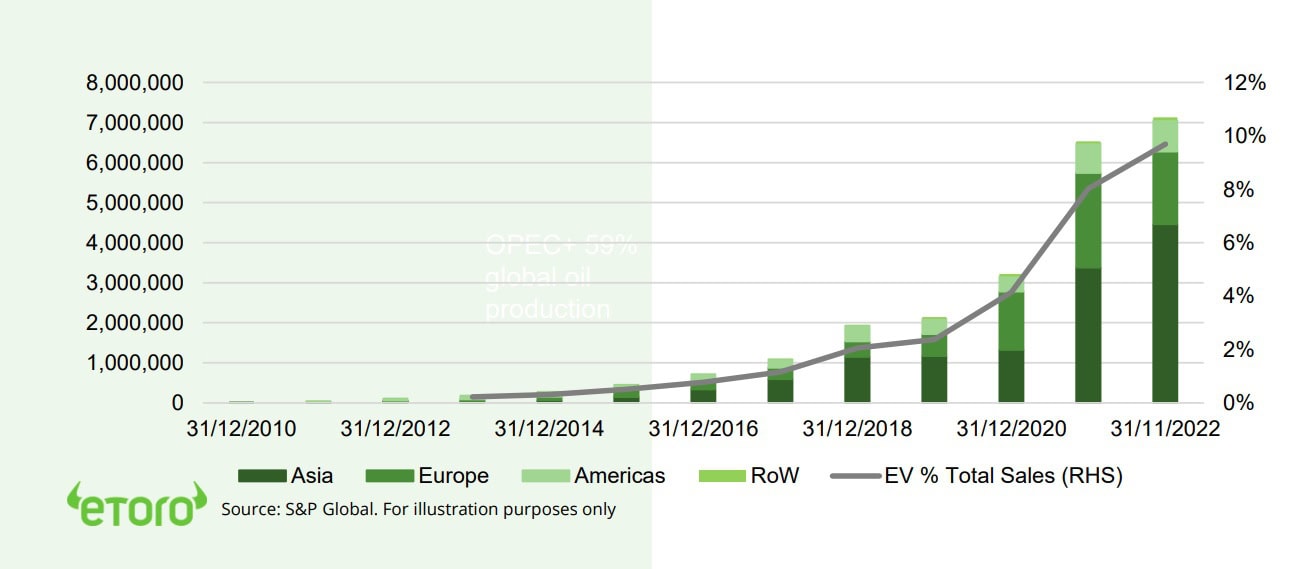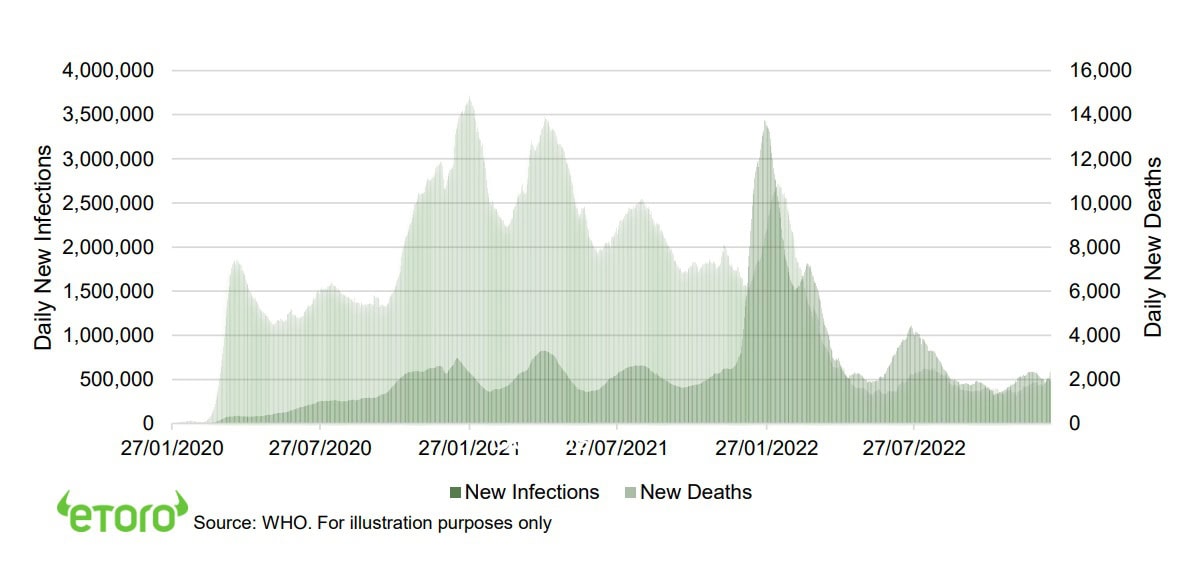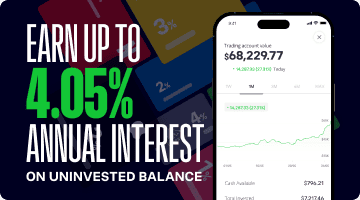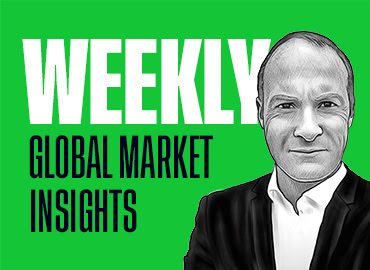Summary
The long investment legacy of covid
Three years after first covid death and investors have moved to other worries. But we continue to live with its consequences. China now ‘goes for growth’ and ends its zero-covid policy, with big global impacts. 2020’s huge spending shortened the recession but drove today’s high inflation and goods boom payback. Covid tightened jobs markets, accelerated WFH trends, and unleashed biotech innovation. Its legacy is long.
Last years losers are now leading
The losers of last year are leading up so-far this. Helped by 6th straight US inflation fall, EU natgas price plunge, and China’s fast reopening. Bitcoin, China, tech, bonds have led higher. Whilst dollar and commodities are down. US 10-yr bond yields fell to 3.5% and JPY breached 130. JPM kicked off Q4 earnings, as GS and BLK follow tech with job cuts. TSLA slashes prices and DIS faces an activist investor. 2023 Year Ahead View HERE. See video updates, twitter @laidler_ben. We are back in January 2023. Happy holidays!
Earnings fears are overdone
Consensus S&P 500 Q4 earnings growth may see first fall since Q3 2020. We are less negative. See another ‘less-bad’ season. Economy is growing, USD weaker, EPS forecasts slumped.
Inflation is the main event
Falling US inflation is the biggest market driver. December CPI brought good news. A 6th straight headline growth fall to 6.5%. Our inflation tracker says prices pressures keep easing.
Tech sector down but not out
Tech stocks performed badly last year, and are key to better 2023 for markets. We see weak profits but valuation relief. @BigTech.
Electric vehicle growth is fine
Electric vehicle stocks been under pressure. But volumes to grow 40% this year and penetration only is 2%. @Driverless, @ChinaCar.
Crypto reversing 2022 losses
Crypto staked out early asset class performance lead in 2023 as tries to reverse last year’s 65% plunge. Came even as saw more crypto job cuts and lawsuits. Bitcoin (BTC) hit $20,000 as macro risks eased, with asset class expectations low. AVAX led up on an Amazon (AMZN) deal. ADA on coming network upgrades optimism.
Energy leads a commodity rebound
The better macro outlook drove a stronger week for commodities. As US inflation fell, the dollar eased, and China’s reopening picked up. Energy rebounded ahead of the next round of EU-Russia sanctions. Copper hit a 6 month high on supply concerns in top producers Chile and Peru. Coffee fell on higher supply and inventories.
The week ahead: earnings and Asia focus
1) First US earnings season full week, with banks MS and GS, plus big tech NFLX, and PG, UAL. 2) China reopening focus as set for Q4 GDP fall and start of its NY data drought. 3) BoJ meet as inch to tighten policy and JPY rallies. 4) MLK holiday in US (Mon) and WEF meets in Davos.
Our key views: A gradual U-shaped recovery
Lower inflation key to relief from double-barrel interest rate and recession pressures. We see a gradual and U-shaped recovery. 1H focus cheap and defensive assets, from healthcare to UK. Room for more aggressive 2H, as lower inflation de-risks markets. Stickier inflation or higher-for longer Fed mistake the big concerns.
Top Index Performance
| 1 Week | 1 Month | YTD | |
| DJ30 | 2.00% | 4.20% | 3.49% |
| SPX500 | 2.67% | 3.81% | 4.16% |
| NASDAQ | 4.82% | 3.49% | 5.85% |
| UK100 | 1.88% | 6.98% | 5.26% |
| GER30 | 3.26% | 8.59% | 8.35% |
| JPN225 | 0.56% | -5.11% | 0.10% |
| HKG50 | 3.56% | 11.76% | 9.89% |
*Data accurate as of 16/01/2023
Market Views
Last years losers are leading up
- The losers of last year are leading up so-far this. Helped by 6th straight US inflation fall, EU natgas price plunge, and China’s fast reopening. Bitcoin, China, tech, bonds have led higher. Whilst dollar and commodities are down. US 10-yr bond yields fell to 3.5% and JPY breached 130. JPM kicked off Q4 earnings, as GS and BLK follow tech with job cuts. TSLA slashes prices and DIS faces an activist investor. See our 2023 Year Ahead View HERE.
Earnings fears are overdone
- Fed interest rate hikes will start catching up with both the economy and earnings in 2023. This will flip the script on last year’s resilient earnings and plunging valuations. Q4 earnings are a prelude to this and may see first US fall since Q3 2020.
- But we are less negative and see another ‘less bad’ season. With lower but resilient profits and margins giving some relief to worried investors. S&P 500 Q4 estimates already been cut 16pp, GDP a robust +4%, and dollar weaker. Consensus is for S&P 500 earnings to fall -2% (see chart) whilst Europe’ Stoxx 600 rise 14%. Management 2023 guidance will be a focus.
Inflation is the main event
- An easing inflation and interest rate shock is the most important of three market catalysts we see. Ahead of China going-for-growth and a less-bad tech view. US inflation is world’s most important number. It drives all else, from Fed hiking outlook to recession risks and earnings outlook. December saw 6th straight headline fall to 6.5%.
- Our inflation tracker of leading and coincident inflation indicators, from housing and labour markets to commodities and supply chains, says more falls are ahead. It shows price pressures down 24% from peak. And 5% from November levels, with 11 of 14 measures down.
Tech sector down but not out
- IT, Communications and tech-heavy Discretionary sectors dominate. ‘Tech’ is 43% of US equities, and 28% overseas. They performed terribly last year, and a better 2023 is key to markets. Their profits outlook is weak as head into Q4 earnings. With a double-whammy of demand payback for 2020/1 covid boom and a building cyclical slowdown.
- But they have defences. 1) Big profit margins and fortress balance sheets. 2) Moving fast to cut costs. 3) Peak 30% valuation premium gone, and helped by lower bond yields. See @BigTech.
Electric vehicle growth is fine
- Electric vehicle stocks been under pressure. With triple-impact of demand concerns, supply chain issues, and normalizing valuations. Is starting to throw up opportunities. Demand still strong, supply chains better, valuations re-entering stratosphere. Could attract institutional investors, a key driver with Tesla retail ownership already 3x typical levels.
- Slowing demand is for all cars, not just EV’s, with cyclical headwinds of falling consumer confidence and rising financing costs. EV’s are seeing first ever battery cost rise and lower China and US subsidies. EV growth still set to be 40% this year and overall penetration rate only 2%. @Driverless, @ChinaCar.
Global electric vehicle sales – total and as % of overall new car sales

Crypto reverses 2022 losses
- Crypto has staked out an early lead as the best performing asset class of 2023, with both bitcoin (BTC) and Ethereum (ETH) up strongly.
- The asset class is trying as to rebound from its dramatic -65% losses of last year. It has been boosted by easing macro concerns, as inflation has eased, and with poor sentiment a contrarian positive. This has more than offset continued crypto industry job cuts and lawsuits.
- Avalanche (AVAX) led recent asset class gains as Amazon Web Services teamed up with Ava Labs to support its blockchain. Cardano (ADA) also performed strongly on investor optimism over the upcoming CIP 1694 and MBO upgrades.
Energy leads a commodities rebound
- Commodities had a good week as oil prices rebounded ahead of February’s tightening of EU sanctions on Russia’s refined exports. Optimism on a pick up in Chinese demand accelerated as it reopened its borders for first time in three years. A weaker US dollar provided a further tailwind.
- Copper prices rose to six month high, with China half total world demand. No.1 producer Chile warned its production would fall this year, and political turmoil continued in no2. producer Peru.
- Coffee prices fell back on the outlook for strong supplies from no.1 producer Brazil, after recent rains, and as Arabica inventory levels rose.
US Equity Sectors, Themes, Crypto assets
| 1 Week | 1 Month | YTD | |
| IT | 4.82% | -2.13% | 5.48% |
| Healthcare | 0.31% | -2.26% | 0.20% |
| C Cyclicals | 5.44% | 0.98% | 8.72% |
| Small Caps | 5.26% | 2.98% | 7.14% |
| Value | 0.92% | 0.47% | 3.12% |
| Bitcoin | 14.28% | 9.33% | 17.28% |
| Ethereum | 11.96% | 8.16% | 18.98% |
Source: Refinitiv, MSCI, FTSE Russell
The week ahead: earnings and Asia in focus
- First full week of US Q4 earnings season with GS, MS ending major US banks, plus big tech NFLX, and PG, UAL. Consensus for a -2% S&P 500 Q4 earnings fall. We are more positive.
- Data in China to show why quickly moved to reopen borders after 3yr covid lockdown. Q4 GDP seen slumping 0.8% QoQ. Dec. retail sales -8%. Now a new year data drought until March.
- More Asia focus as Bank of Japan meeting (Wed) inches toward tightening its outlier monetary policy. Kuroda replacement naming is near. JPY/USD strengthened through 130.
- US capital markets are closed (Mon) for the Martin Luther King holiday. Whilst corporate and world leaders attend the World Economic Forum meetings in Davos, January. 16-20.
Our key views: A gradual U-shaped recovery
- Inflation cycle to gradually turn down, allowing interest rate hikes to stop. Whilst consumer and earnings stay resilient. Equity markets likely bottomed but recovery U-shaped and bumpy. But will eventually start to de-risk markets and see higher risk assets from equities to crypto to sustainably recover as rate cuts come to focus.
- Focus on core cheap and defensive assets to be invested in this ‘new’ world, of higher inflation and lower growth, and to manage still high risks. Sectors, like healthcare, defensive styles like div. yield, and related UK to Japan markets.
Fixed Income, Commodities, Currencies
| 1 Week | 1 Month | YTD | |
| Commod* | 3.21% | -1.00% | -1.09% |
| Brent Oil | 8.69% | 7.78% | -0.65% |
| Gold Spot | 2.81% | 6.66% | 5.08% |
| DXY USD | -1.64% | -2.41% | -1.30% |
| EUR/USD | 1.78% | 2.32% | 1.21% |
| US 10Yr Yld | -5.73% | 1.67% | -37.42% |
| VIX Vol. | -13.16% | -18.18% | -4.38% |
Source: Refinitiv. * Broad based Bloomberg commodity index
Focus of Week: the long investment legacy of covid
Three years on from start of covid crisis, and China ‘goes for growth’ by ending its zero-covid policy
Last week was the 3rd anniversary of the first reported covid death. Much of the world has since moved on from the pandemic. 70% of the global population has been vaccinated, more have some natural infection immunity, and the covid strains become less severe. It has plunged as perceived risk for consumers and investors, quickly replaced by soaring inflation. But it remains a powerful investment driver, with impacts likely with us for years to come. Covid has not gone away (see chart). China is now rapidly easing the world’s last major zero-covid strategy. Whilst the rest of the world has learnt to live with it, we continue to see the investment impacts across labour, housing, and healthcare markets – to name just three.
The final reopening of China is faster than expected and with big global implications
A faster than expected reopening of the Chinese economy has come as it ditches its long standing zero covid policy in response to its slumping economic growth pace. This will eventually be a significant support to its own and to the global economy. China is the only major country set to grow more this year than last. This has global implications, from commodities to luxury goods sector to related economies like Australia and Germany. It also comes alongside a positive step up in China’s support to its critical property sector (25% of GDP) and an easing of its tech sector (c50% its equity market) regulatory crackdown.
Massive government covid spending shortened the recession but drove today’s inflation panic
The covid pandemic shock drove by far the biggest and shortest global recession in history. It saw a dramatic spending response from western governments. This shortened the recession but at a cost. It pushed global debt levels to unprecedented high levels. Contributed to higher and stickier inflation, and the current high-for-longer interest rate outlook. This is worsened by the many ‘long covid’ sufferers. The US labour force participation rate is a point below pre covid levels, or 1.6 million. And not all could provide this support. Economic activity in many emerging markets is still up to 7pp lower than pre-pandemic levels.
Work-from-home trends and biotech innovation are big legacies as the goods boom slows
Global work-from-home trends are here to stay for many, and a fundamental change. Communications and e-commerce have seen step-changes in adoption, with implications from Zoom (ZM) to Twilio (TW). Whilst US office occupancy levels are stuck at 50% of prior levels, hurting REITS from Alexandria (ARE) to Boston Properties (BXP). The world’s fastest ever vaccine development and new mRNA tech has thrown up opportunity across infectious disease and cancers for likes of BioNTech (BNTX) and Moderna (MRNA). See @Vaccine-Med. The pandemic goods boom pulled forward much demand. This has slowed and combined with sharply lower valuations to be a double hit to the tech sector, the largest in global stock markets.
World covid new cases and deaths trend the last three years

Key Views
| The eToro Market Strategy View | |
| Global Overview | Aggressive Fed interest rate hiking cycle and stubborn inflation boosted uncertainty, recession risk, and hit markets. We see this gradually fading in 2023, with global growth stressed but resilient, inflation pressure slowly easing, and valuations now more attractive. Focus on cheap and defensive assets for a gradual ‘U-shaped’ market recovery. |
| Traffic lights* | Equity Market Outlook |
| United States | World’s largest equity market (60% of total) seeing slowing but resilient GDP and earnings growth. Valuations led the market rout, and now below average levels, and are supported high company profitability and near peaked bond yields. Fast Fed hiking cycle boosted recession risks. Focus on cash-flows defensives, like healthcare and high dividend. Big-tech supported by defensive growth. See gradual ‘U-shaped’ rebound as inflation slowly falls and de-risks market. |
| Europe & UK | Favour defensive and cheap UK equities (‘Economies are not stock-markets’) over high risk/high return continental Europe. Recession risks high with Russia and energy crisis, threatening to overwhelm ‘buffers’ of rising fiscal spending (defence and refugees), low interest rates (slow to raise ECB), and weak Euro (50%+ sales from overseas). Equities partly cushioned by lack of tech, and 25% cheaper valuations vs US. Favour cheap and defensive UK over Continent. |
| Emerging Markets (EM) | China, Korea, Taiwan dominate EM (60% wt.), and more tech-centric than US. Positive on China as economy reopens, cuts interest rates, and eases tech regulation crackdown. Valuations 40% cheaper than US and market out of favour. Recovery helps global sectors from luxury to materials. Broader EM needs weaker USD and peak US rates catalyst. |
| Other International (JP, AUS, CN) | Canada and Australia benefit from strong equity market weight in commodities and financials, if global growth resilient and bond yields risen. Japanese equities among cheapest of any major market, benefit from weaker JPY and with low inflation, offsetting structural headwinds of low GDP growth, an ageing population, and world’s highest debt. |
| Traffic lights* | Equity Sector & Themes Outlook |
| Tech | ‘Tech’ sectors of IT, communications, consumer discretionary (Amazon, Tesla), dominate US and China. Hurt by higher bond yields and above average valuations. But structural stories with good growth, high margins, fortress balance sheets support some. ‘Big-tech’ attractive new recession defensives. ‘Disruptive’ tech is much more vulnerable. |
| Defensives | Core positions as macro risks rise and bond yields are better priced. Consumer staples, utilities, real estate attractive defensive cash flows, less exposed to rising economic growth risks, and robust dividends. Offset impact of higher bond yields. Healthcare most attractive, with cheaper valuations, more growth, some rising cost protection. |
| Cyclicals | Higher risk cyclical sectors, like discretionary (autos, apparel, restaurants), industrials, energy, and materials, are cheap and attractive if see a ‘slowdown not recession’ scenario. Are select but high risk opportunities from energy to financials stocks. With often depressed earnings, cheaper valuations, and have been out-of-favour for many years. |
| Financials | Benefits from high bond yields, charging more for loans than pay for deposits. Also one of cheapest P/E valuations, and with room for large dividend and buyback yields. But can be outweighed by high recession risks, with lower loan demand and higher defaults. Banks most exposed. Insurance and Diversifieds (like Berkshire Hathaway) the least. |
| Themes | We favour Value over Growth on GDP resilience, lower valuations, rising bond yields, under-ownership after decade under-performance. Dividends and buybacks recovering with cash flows. Power of dividends under-estimated, at up to 1/2 of total long term return. Secular growth of Renewables and Disruptive Tech investment themes. |
| Traffic lights* | Other Assets |
| Currencies | USD ‘wrecking ball’ driven by rising Fed interest rates and ‘safer-haven’ bid. Many DM currencies hurt by still low interest rates and struggling growth. ‘Reverse FX war’ interventions ineffective. Strong USD hurt EM, commodities, US foreign earners like tech. But helps big EU and Japan exporters. Stabler USD outlook as near top of Fed cycle. |
| Fixed Income | US 10-year bond yields risen above prior 3.5% peak, as Fed hikes continue aggressively and balance sheet runoff accelerates. Set to ease as recession risks rise and inflation expectations fall. Additionally US has a wide spread to other market bond yields, and structural headwinds of all-time high debt, poor demographics, low productivity. |
| Commodities | Strong USD and rising recession fears hit commodities. But still above average prices helped by GDP growth, ‘green’ industry demand, supply under-investment, recovering China, Russia supply crisis. Oil helped by slow return of OPEC+ supply and Russia 10% world oil supply problems. But commodities not to repeat their 2022 performance leadership. |
| Crypto | In the latest ‘crypto winter’ (16th crash for bitcoin) with dramatic and early asset class sell-off and later specific risk events from Luna to FTX. See long term asset class development with small size under $1 trillion, correlations low, regulation growing, development/catalysts continuing – Ethereum merge to proof-of-stake and coming BTC halving. |
| *Methodology: | Our guide to where we see better risk-adjusted outlook. Not investment advice. |
| Positive | Overall positive view, and expected to outperform the asset class on a 12-month view. |
| Neutral | Overall neutral view, with elements of strength and weakness on a 12-month view |
| Cautious | Overall cautious view, and expected to underperform the asset class on a 12-month view |
Source: eToro
Analyst Team
| Global Analyst Team | |
| CIO | Gil Shapira |
| Global Markets Strategist | Ben Laidler |
| United States | Callie Cox |
| United Kingdom | Adam Vettese Mark Crouch Simon Peters |
| France | Antoine Fraysse Soulier David Derhy |
| Holland | Jean-Paul van Oudheusden |
| Italy | Gabriel Dabach |
| Iberia/LatAm | Javier Molina |
| Poland | Pawel Majtkowski |
| Romania | Bogdan Maioreanu |
| Asia | Nemo Qin Marco Ma |
| Australia | Josh Gilbert |
Research Resources
Research Library
eToro Plus: In-Depth Analysis. Dive deeper into market insights: Read daily, weekly and quarterly summaries, catch up on the latest market trends and get the most recent, in-depth overview of markets.
Presentation
Find our twice monthly global markets presentation on the multi-asset investment outlook.
Webinars
Join our live Weekly Outlook webinars every Monday at 1pm GMT, or watch the replay at your convenience. Also see the other online courses and webinars.
Videos
Subscribe to our timely video updates on market moving events, and the ‘week ahead’ view
Follow us on twitter at @laidler_ben
COMPLIANCE DISCLAIMER
This communication is for information and education purposes only and should not be taken as investment advice, a personal recommendation, or an offer of, or solicitation to buy or sell, any financial instruments. This material has been prepared without taking into account any particular recipient’s investment objectives or financial situation and has not been prepared in accordance with the legal and regulatory requirements to promote independent research. Any references to past or future performance of a financial instrument, index or a packaged investment product are not, and should not be taken as, a reliable indicator of future results. eToro makes no representation and assumes no liability as to the accuracy or completeness of the content of this publication.






